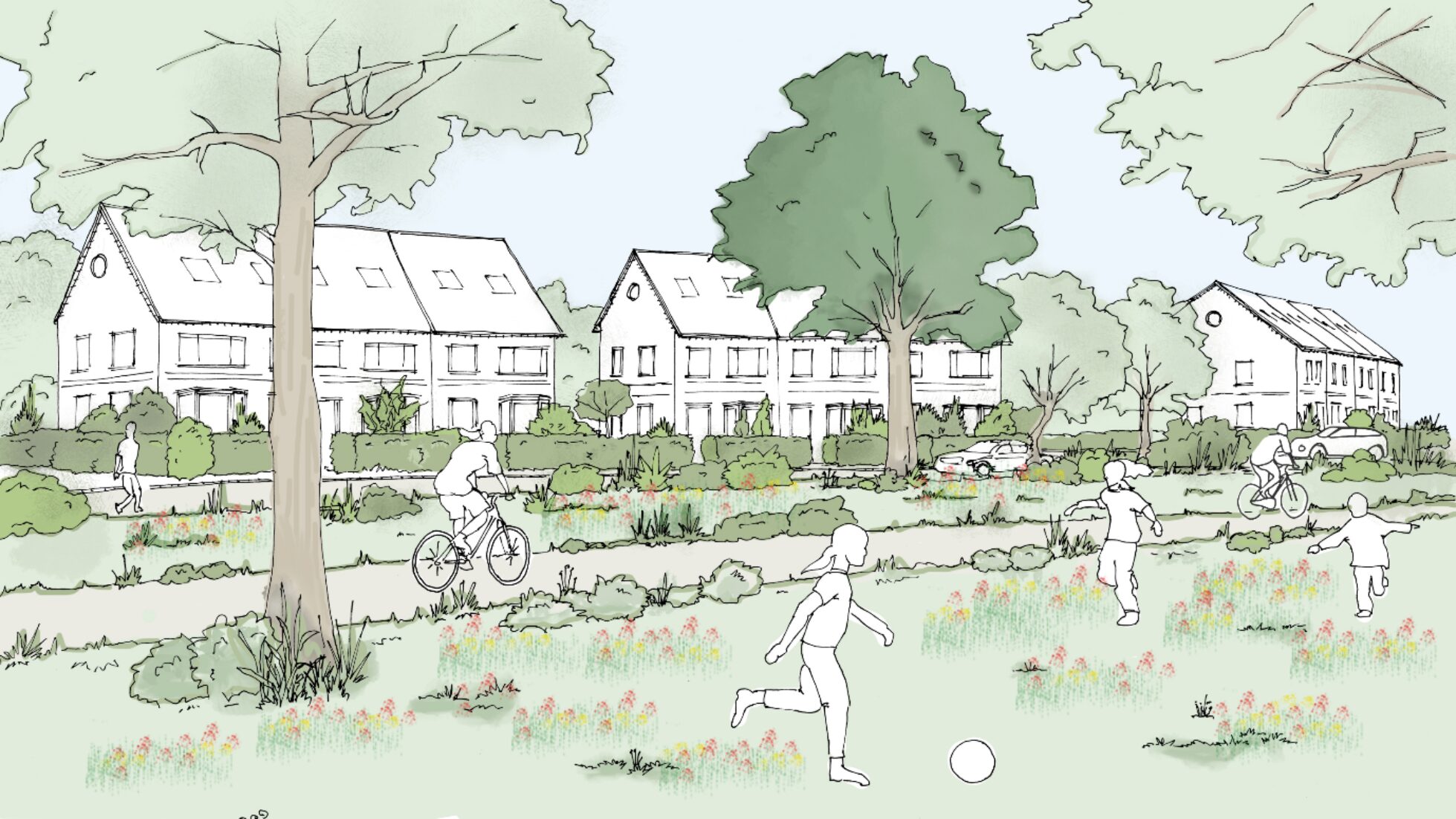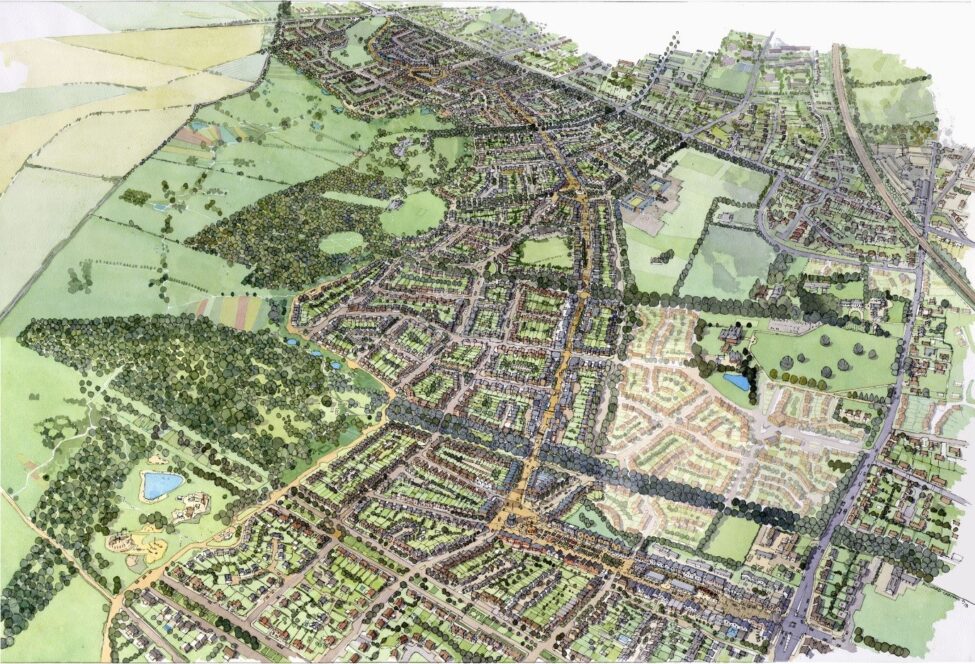How to deliver garden communities at pace

A number of garden communities are either planned or under construction across England, helping to close the housing supply gap. Yet, with thousands of homes within the UK still to be built – despite having planning permission – masterplanner Patrick Clarke looks at how to speed up the delivery of these large-scale projects while ensuring they’re high quality developments.
Garden communities are locally-led communities, designed to promote community inclusion and walkable, sociable and vibrant neighbourhoods. Garden communities are at the heart of the UK government’s ambition to build 300,000 new homes per year in England by the mid-2020s to help ease the housing shortage.
Through its Garden Communities Programme, the government is helping fund more than 20 garden community projects, delivering 200,000 homes by mid-century, with a further round of projects recently announced. Garden communities typically include garden villages of 1,500 – 10,000 homes or garden towns of more than 10,000 homes.
But with government figures revealing that, as of July 2016, just over half the 684,000 homes with planning permission in the UK had been completed and, as local council and private developers’ ambitious visions for Garden Community Programme sites move into practical delivery, it is crucial that these strategic projects deliver a wide range of high-quality homes at pace – alongside necessary supporting infrastructure.
Achieving pace and quality
While the Town and County Planning Association’s Garden City Principles provides an excellent framework for local councils and developers to follow when delivering large scale housing schemes, setting out clear standards for placemaking, sustainability, long-term stewardship and community development, faster-paced design and development are often seen to be at odds with the creation of quality places. But this needn’t be the case.
Here are three ways to help unlock faster garden community delivery and provide attractive, vibrant and well-connected places where people want to live:
1. Include a wider range of homes

As suggested in the Letwin Review of Build Out Rates, which looks at why houses are taking so long to be built despite having planning permission, it is possible to deliver homes on major strategic sites more quickly by widening the range of homes on offer.
According to the Letwin Review, once detailed planning permission is granted for large sites, the fundamental driver of build out rates appears to be the ‘absorption rate’ or rate at which homes are sold. Generally, house sale rates are determined by the type and price of houses on offer. Including a diverse range of homes from one-bedroom apartments to four-bedroom family homes and bungalows will appeal to a wider range of buyer, increasing the overall demand. This, in turn, will help maintain house values and scheme viability, leading to a significant uplift in the number of homes built each year.
Typically, greenfield sites provide mostly larger, multiple-bedroom homes because families tend to be the buyers most willing to trade proximity to the office for open, green spaces and being close to good schools. However, broadening the mix to include more apartments — which often account for around just 20 per cent of garden community housing — and other specialised housing types, such as retirement homes, creates more balanced and sustainable communities in line with the Letwin Review recommendations.
Research also shows that developments with 40 per cent or more affordable housing have a 40 per cent higher build out rate compared to developments with 10 to 19 per cent. At the same time, a diversity of tenures, such as built to rent properties alongside owner-occupier homes, further widen the market and balance out community demographics.
2. Invest in high-quality public transport
Investment in high-quality public transport infrastructure and services, such as good and frequent bus and rapid transit services, or even re-opening or converting an abandoned railway into a tramway, is crucial to stimulating the greater demand from buyers required to support a diversified housing approach. The UK’s original garden city sites, Letchworth and Welwyn Garden City in Hertfordshire, for example, were chosen because of their location on railway lines that offered reliable public transport services to London.
Simply put, access to good public transport boosts people’s interest in living in a community because it gives them the opportunity to get about affordably, quickly and safely, without needing a car. Good public transport options are also a catalyst for the construction of higher density homes because they support a wider mix of activities and services, and also increase property prices. In addition, they reduce the amount of space needed for car parking, allowing land to be developed more intensively. These connections may seem obvious but the often-fragmented nature of public transport provision outside of our major cities tends to undermine efforts to integrate planning around public transport investment.
Using a transport orientated development (TOD) approach when masterplanning garden communities can create a virtuous circle where public transport investment stimulates higher density development, which in turn increases passenger numbers and therefore supports the long-term viability of the public transport services provided. Further to this, in many cases, the additional construction and operational costs of building high-quality public transport networks as part of a garden community would be relatively modest when set against overall strategic infrastructure costs.
3. Include ‘traditional’ town characteristics
The more garden communities reflect the characteristics of traditional towns – with green spaces and playing fields – the greater the opportunity to not only create attractive and vibrant places, but also include more diverse housing. This reinforces the central point around the diversity of homes leading to higher absorption and therefore built-out rates. A picturesque lake, for example, can naturally lend itself to having nursing homes or apartments with balconies built around it.
It is possible to determine which characteristics to include and where through an in-depth consideration of a place and the natural assets of the landscape. Conducting this early analysis during masterplanning will help ensure a place-making strategy is developed that supports the creation of a range of different and characterful neighbourhoods within a garden community that will appeal to a wide range of housing types, lifestyles and ultimately, buyers.
Garden Cities were developed at the end of the 19th Century and the garden communities’ model has been adapted and now has significant potential to unlock space and housing for the next generation of buyers. There are currently five successful garden community bids – making use of the £3.7 million fund announced by the Minister of State for Housing – delivering 64,000 new homes across England and we look forward to seeing these significant schemes develop.

